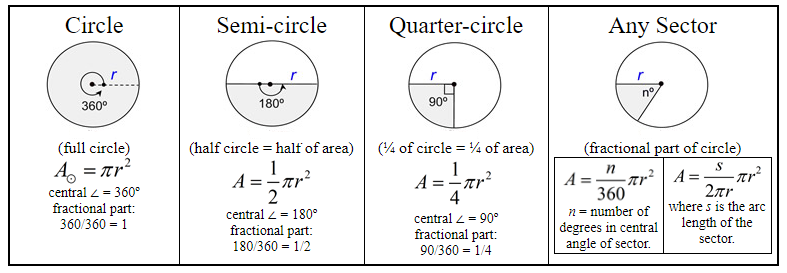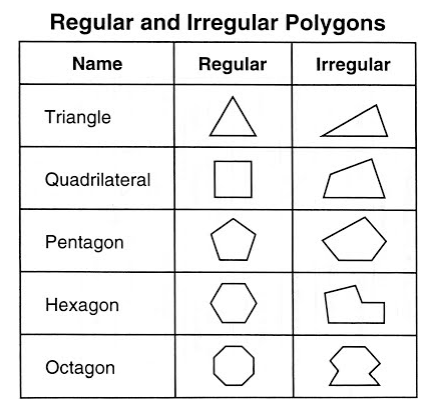Open and Closed Figures in Geometry
Closed Figures: Figures in which initial and end points coincide with each other are called closed figures.
Examples:

Open Figures: Figures which have different initial and end points are called open figures.
Examples:

Observe these closed figures:
 Closed figures (i) and (ii) are different from (iii) and (iv). In figures (iii) and (iv) line segments cross themselves at one or more points. Thus, closed figures, which cross themselves at one or more points, are called complex closed figures, and the figures which do not cross themselves at any point are called simple closed figures. So, figures (i) and (ii) show simple closed figures and (iii) and (iv) show complex closed figures.
Closed figures (i) and (ii) are different from (iii) and (iv). In figures (iii) and (iv) line segments cross themselves at one or more points. Thus, closed figures, which cross themselves at one or more points, are called complex closed figures, and the figures which do not cross themselves at any point are called simple closed figures. So, figures (i) and (ii) show simple closed figures and (iii) and (iv) show complex closed figures.
Inferior and exterior of closed figures
Let us consider the following closed figures.
 Each of these simple closed figures divides the plane into three parts. The first part is covered with cross (×), the second is the dotted part (•), and the third is the boundary of the figures. The part covered with crosses forms the interior of the figure. The part containing the dots, i.e., M, N, O, S, is called the exterior of the figures and the points A, B, C, D, E and P, Q, R lying on the boundary are called the points on the boundary of the figure.
Each of these simple closed figures divides the plane into three parts. The first part is covered with cross (×), the second is the dotted part (•), and the third is the boundary of the figures. The part covered with crosses forms the interior of the figure. The part containing the dots, i.e., M, N, O, S, is called the exterior of the figures and the points A, B, C, D, E and P, Q, R lying on the boundary are called the points on the boundary of the figure.
POLYGON
Simple closed figures having three or more line segments are called polygons. Polygons are further divided into various categories, depending upon the line segments they have.

Similarly, six, seven, eight, nine, and ten sided polygons are called hexagon, heptagon, octagon, nonagon, and decagon respectively. In general, we say that polygon is a rectilinear figure bounded by three or more sides.
Curvilinear and linear boundaries
Curvilinear: Curvilinear means curved line. So, a boundary containing only curved lines or surface is called a curvilinear boundary.
Examples:

Linear: Linear means straight line. So, a boundary containing only line segments or straight lines is called a linear boundary.
Examples:

Some figures have both curvilinear and linear boundaries.
Examples:











 Closed figures (i) and (ii) are different from (iii) and (iv). In figures (iii) and (iv) line segments cross themselves at one or more points. Thus, closed figures, which cross themselves at one or more points, are called complex closed figures, and the figures which do not cross themselves at any point are called simple closed figures. So, figures (i) and (ii) show simple closed figures and (iii) and (iv) show complex closed figures.
Closed figures (i) and (ii) are different from (iii) and (iv). In figures (iii) and (iv) line segments cross themselves at one or more points. Thus, closed figures, which cross themselves at one or more points, are called complex closed figures, and the figures which do not cross themselves at any point are called simple closed figures. So, figures (i) and (ii) show simple closed figures and (iii) and (iv) show complex closed figures. Each of these simple closed figures divides the plane into three parts. The first part is covered with cross (×), the second is the dotted part (•), and the third is the boundary of the figures. The part covered with crosses forms the interior of the figure. The part containing the dots, i.e., M, N, O, S, is called the exterior of the figures and the points A, B, C, D, E and P, Q, R lying on the boundary are called the points on the boundary of the figure.
Each of these simple closed figures divides the plane into three parts. The first part is covered with cross (×), the second is the dotted part (•), and the third is the boundary of the figures. The part covered with crosses forms the interior of the figure. The part containing the dots, i.e., M, N, O, S, is called the exterior of the figures and the points A, B, C, D, E and P, Q, R lying on the boundary are called the points on the boundary of the figure.


